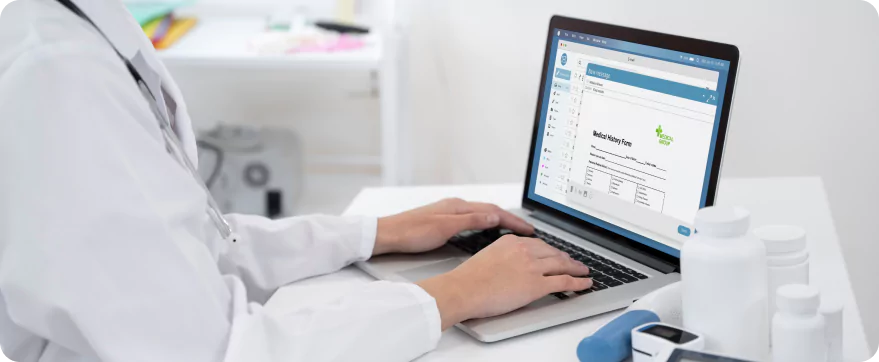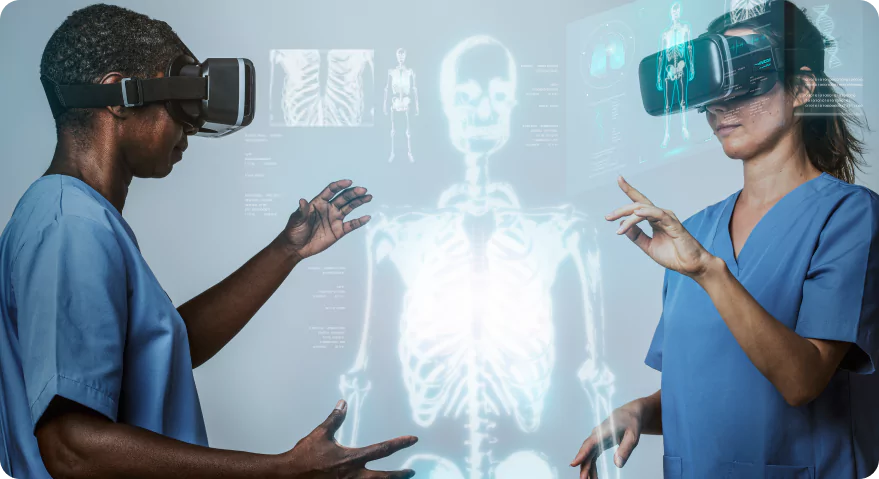Table of Contents
There’s no doubt – medical software can tremendously improve all healthcare-related processes for both patients and doctors. Besides that, it can decrease costs, save time, and improve efficiency.
So, it comes as no surprise that medical software development is only growing in popularity. The market is predicted to grow at its highest rate between 2022 and 2029, with a forecast to reach 53.22 billion in this period.
Let’s delve into the world of healthcare software development and discover the main types of medical software, the step-by-step process of creating them, and other FAQs.
What is Medical Software Development?
Medical software development includes all processes that go into making web and mobile apps tailored to serve the healthcare industry.
Such solutions can be used by hospitals, patients, medical billing services, clinical and research centers, and medical equipment providers.
As medical software can serve a wide range of customers in the industry, there are different medical software types.
Let’s take a look at some of the most popular ones.
Main 10 Types of Medical Software
Check out the main types of medical software used by healthcare providers, patients, and hospitals:
- 1. Practice Management Systems
- 2. Lab Information Management Systems (LIMS)
- 3. Billing Software
- 4. Health Information Systems
- 5. Medical Imaging Software
- 6. Patient Portals
- 7. E-Prescribing Software
- 8. Urgent Care
- 9. Hospital Management Software
- 10. Telehealth Software


Practice Management Systems
A practice management system (also known as clinic management software) is a CRM designed to handle medical practices and all their clinical and administrative workflows.
This solution can be used by dentists, physicians, general practitioners, and other specialists. Based on their individual requirements, this software can be linked with pharmacies and labs or even have custom features like prescription management, clinic queue monitoring, health record keeping, scheduling, and billing.
The advantage of this software is that it:
- Minimizes errors
- Enhances workflow efficiency
- Reduces costs
- Improves the quality of patient care

Lab Information Management Systems (LIMS)
Lab information management systems handle all vital lab processes, including:
- Error-free report generation for all lab samples
- Alerting when lab samples show any abnormal results
- Full inventory management
- Integrate with lab equipment
- Billing functionalities

Billing Software
Nowadays, most medical software can be programmed to have a billing feature.
But hospitals and medical facilities with a higher number of transactions and invoice records can use a separate billing software solution. Such apps are tailored to track, record, and process invoices, insurance claims, and medical bills.


Health Information Systems
EMR:
Electronic medical records are digitized versions of a patient’s records. They allow medical professionals to access data in seconds, eliminating the need to go through paper archives. However, EMRs can’t be shared outside of the organization.
EHR:
Electronic health records are similar to EMRs, but they are interoperable. This means they can be shared with other hospitals, labs, and healthcare institutions. Such records store information about lab results, medical history, and other vital patient information. The development of these interoperable systems is complex and requires specialized ehr software development expertise to ensure seamless integration and communication between different healthcare providers.
PHR:
Personal health record systems provide a safe and secure way for patients to manage all their health-related information. Such electronic applications store all patient-related data provided by the caregivers, patients, pharmacies, and labs.
HIE:
Health information exchange systems aid the transmission of patient data electronically between doctors, pharmacists, and other healthcare providers. This allows the fast and easy sharing of information that helps avoid errors and improve diagnoses.

Medical Imaging Software
Medical imaging software development helps practitioners to track, manipulate, and manage medical images. The industry is slowly moving away from the less advanced 2D imaging solutions to the more advanced 3D and 4D ones.
For example, 3D imaging software can model the human body and different body parts and even create dental models. This allows professionals to create more personalized images of patients and even design prosthetic limbs and other medical equipment.
On the other hand, 4D imaging is mostly used in radiation therapy.

Patient Portals
Patient web and mobile app portals allow patients to easily access their medical records. These portals also allow them to view and manage their:
- Online consultations
- Appointments
- Billing
- Patient history

E-Prescribing Software
This software allows doctors to send medical prescriptions to pharmacies electronically. This enables accurate, safe, and efficient communication between hospitals, pharmacies, and labs.
So, no more waiting at the pharmacy to get your prescription processed!

Urgent Care
Urgent care software is tailored to the unique workflows of urgent care centers. Such software aids the efficient management of urgent cases. It also enables doctors to access all vital patient records in a timely manner and helps reduce labor costs.

Hospital Management Software
This type of software is designed to optimize all hospital management-related processes, including:
- Billing and insurance
- Administrative tasks
- Patient information tracking
- Doctors’ appointments and operations
HMS systems can also manage pharmacies and labs. They can also be integrated with mobile apps and allows patients to see their prescriptions, medical history, and scheduled appointments.

Telehealth Software
Telehealth and telemedicine software enable patients to attend online doctor consultations and connect with their medical providers through texts, audio, and video calls. Telemedicine software development solutions reduce the amount spent on commuting and waiting in lines to see your doctor in person.
The telehealth software industry experienced massive growth during the pandemic. In 2021, its market size reached 40.52 billion, and by 2028, it is predicted to grow to 200.53 billion.

Step-by-Step Process of Developing a Medical Software
At Scopic, we provide high-quality custom healthcare software development solutions that take all your needs and requirements into account. With over 16 years of experience in the medical software development industry, we have established a well-defined step-by-step process that has proven to work time and again.
Step #1:
Gathering Project Requirements
Initially, we kick off the project with a free-of-charge client call, so we understand your healthcare organization, who your end user is, and how the software solution will address your needs.
You can ask us all the questions you have, as we aim to give you the best possible personalized advice.
Step #2:
Analyzing the Problem
Once we have a better understanding of your project requirements, we will create a custom proposal tailored to your specific use case. The pitch will include a detailed breakdown of all the steps we need to take from initiation to deployment and maintenance.
Step #3:
Creating a Detailed Project Plan
Based on your feedback on the initial proposal, we will create a detailed step-by-step actionable plan. The plan will include an execution timeline, exact estimates, and proposed technologies to be used for your customized medical software solution.
Step #4:
Healthcare Project Execution
When we settle on the project plan, we move on to execution. We assign a highly-skilled, HIPAA-certified team of developers to the project.
To deliver the project in a timely and efficient manner, we use an Agile approach. This allows us the most flexibility as we do multiple rounds of prototyping and testing.
This way, we ensure the UI/UX, key functionalities, and other features are programmed in a way that will be an exact match to the software you envisioned.
Step #5:
Testing and Bug Fixing
When we finalize the software solution and ensure everything works smoothly, we send it over to you.
Here, we ensure the medical application meets all the project milestones we set in step #3, and you let us know if the final deliverable aligns with your needs.
Once you review everything and give us the green light, we will launch the project.
Step #6:
Medical Software Deployment
When we finalize the software solution and ensure everything works smoothly, we send it over to you.
Here, we ensure the medical application meets all the project milestones we set in step #3, and you let us know if the final deliverable aligns with your needs. Once you review everything and give us the green light, we will launch the project.
Step #7:
Maintenance and Support Activities
In case you need any maintenance, software updates, or other support activities down the line, we will be there to take care of all that for you.
Medical Software Development FAQs
Still have some questions regarding software development in the medical field?
Here are some common FAQs:
What Does a Medical Software Development Company Do?
The increased demand for medical software has given rise to more specialized medical and healthcare software development companies.
Such companies help NGOs, hospitals, medical schools, and private practitioners to develop advanced software and app solutions that can improve their processes and make them more efficient.
What's the Difference Between Offshore vs. Nearshore vs. Onshore Software Development Services in the Medical Field?
You can hire offshore, onshore, or nearshore software development services.
Here’s a breakdown of what they entail:
Offshore:
Offshoring is the outsourcing of the software development service to a company located in a country in an entirely different geographic region from yours. Many companies go for offshore labor or service as a cheaper alternative.
Nearshore:
The process is called nearshoring when you outsource your medical software development to another country that’s close to or bordering your country.
Onshore:
Here, the software development is performed by a company located in the same country as you.
What are the Main Considerations in Medical Software Engineering?
There are a few considerations you should keep in mind when choosing medical software development service provider:
Experience:
Aim for a company that already has a few medical software projects under its belt. Medical apps have their technicalities, so going for a vetted development team guarantees your app will meet all requirements.
Knowledge:
Find a development company that has a deep understanding of the healthcare industry. This will ensure they truly understand your project and the solution you’re trying to build.
Capacity:
It’s best to aim for a mid- to big-size development company as this means they have all the resources needed to complete your project.
Security measures:
As medical software typically handles sensitive user data, you need to ensure that your team of developers has all required certifications, such as HIPAA and ISO. This ensures your app won’t be penalized or taken down.
How to Estimate Medical Software Development Costs?
A custom healthcare software development company can charge anywhere from $40,000 to over $500,00 for a single project, depending on the solution you’re trying to build. Here are a few factors that affect the end price:
Project complexity:
Here, you need to take into account everything like the complexity of the design, the number of features, and whether you want a cross-platform solution or a simpler app.
Project timeline:
The bottom line is also affected by how much time the project will take to develop. The more complex the project, the longer it takes, and this will be reflected in the final price.
In-house vs. Outsourcing:
You can either go for an in-house team or outsource the project to a professional software development company. The second option is usually more cost-effective, and you can get the same quality end result.
Composition and location of the team:
Also, consider how many employees you can hire and their expertise. And finally, if you go for outsourcing, consider which geographic region you want to target, as this also affects the final price.
How Long Does It Take to Create Medical Software?
The time period for each project varies depending on your requirements and the software’s complexity. A simple app can be built within a few weeks, while more complex projects can take several months.
What Software is Used in Most Hospitals?
While there are many universal software solutions like PolicyManager and Azalea Health, organizations often prefer going for a custom software solution. That’s due to the complexity of their workflows and the need for a more personal approach when building their medical software.
Custom medical software engineering services are the right fit for you if you’re looking to build functionalities that most mainstream solutions don’t offer.
Whenever you’re looking for custom software solution providers, just make sure they are HIPAA-certified. This will ensure your app is 100% compliant.
What is the Most Used Coding in Healthcare Software?
There are various coding languages used in the healthcare software development. Some of the most popular ones include C, C++, PHP, Java, Swift, and HTML.
However, Python is growing in popularity in that field as it’s a simple app language and does not have the same complex syntax as other codes.

Medical Software Development: The Future of Healthcare
The medical software development industry is growing rapidly. With its constant advancements, an increasing number of healthcare providers are incorporating it into their existing systems, making for faster, easier, and more efficient processes that help both specialists and patients.
If you’re looking to build a custom medical software solution, Scopic is here to help.
Contact us to learn more about how we can elevate your healthcare practice to the next level.

This guide was authored by Vesselina Lezginov, and reviewed by Vyacheslav Korchagin, Principal Engineer with experience in leading and delivering complex medical software projects.
Scopic provides quality and informative content, powered by our deep-rooted expertise in software development. Our team of content writers and experts have great knowledge in the latest software technologies, allowing them to break down even the most complex topics in the field. They also know how to tackle topics from a wide range of industries, capture their essence, and deliver valuable content across all digital platforms.





